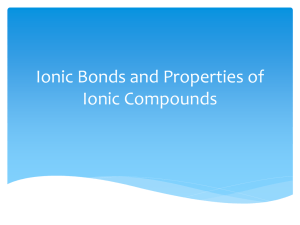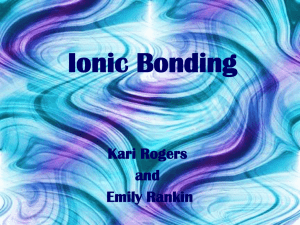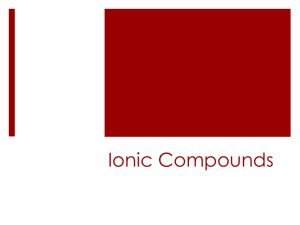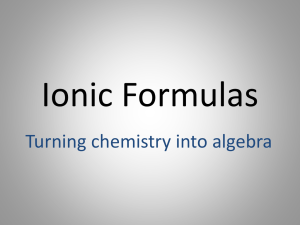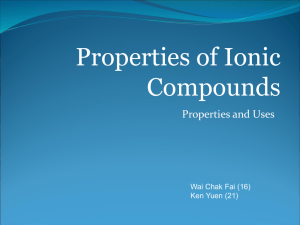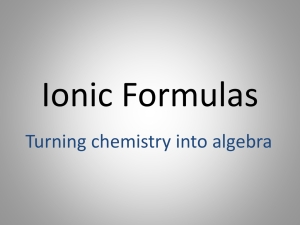ppt
advertisement
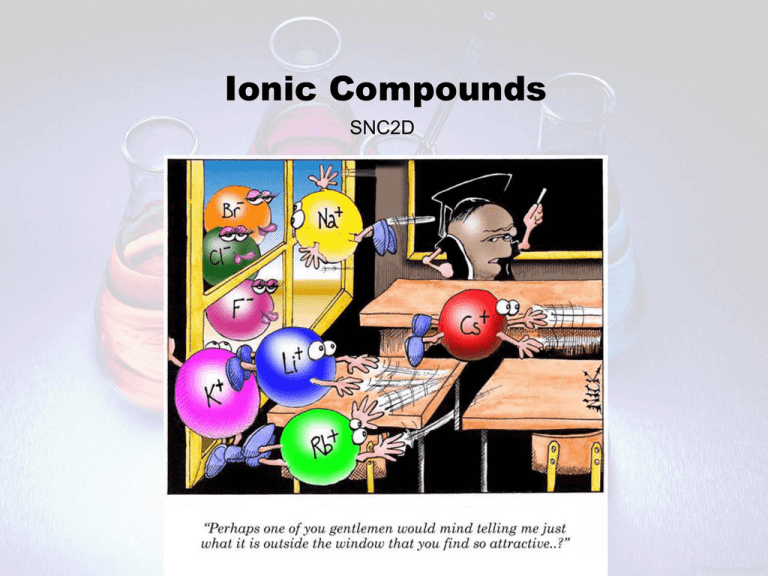
Ionic Compounds SNC2D Review: Terms to Know • Valence – The combining capacity of an element • Valence shell – The outer electron shell of an atom, the electrons in this shell are called valence electrons • Isoelectric with a noble gas – The same number of electrons as a noble gas Review: Anions 1Cl Cl • Easier to gain 1 electron than lose 7. • Therefore the atom becomes an anion by gaining an electron. • It becomes more stable by gaining an electron. It becomes iso-electric with Ar. Review: Cations 1+ Na Na • Easier to lose 1 electron than gain 7. • Therefore the atom becomes a cation by losing an electron. • It becomes more stable by losing an electron. It becomes iso-electric with Ne. • http://teachertube.com/viewVideo.php?vi deo_id=67110 The Ionic Bond • An ionic bond is when an electron from one atom is given to another atom and they are held together by strong electrostatic forces • Ionic compounds are formed when ions form a compound Electrostatic attraction When a metal gives up one or more electrons to a non-metal, the resulting oppositely-charged ions will experience an electrostatic attraction : How Ionic Bonds Form 11+ 1+ Na Na Cl Cl 1- Ionic bonds and compounds This electrostatic attraction is called an ionic bond . The resulting compound is an ionic compound. Solutions An ionic compound dissolved in water is said to be aqueous (aq). Solutions These compounds dissolve in water because one side of the water molecule (H2) is positive and attracts the negative ions and the other side is (O) is negative and attracts the positive ions. Solutions Because the charged ions can move freely, solutions of ionic compounds are good conductors of electricity. Activity • The properties of Ionic Compounds Activity Formulas for Ionic Compounds 1. Write symbols with the metal first (metal+nonmetal or cation+anion) 2. Write the combining capacity (valence or ion charge) for each element over the symbol 3. Use “ c r o s s o v e r ” m e t h o d and reduce numbers to lowest ratio 3+ 2- Al 2S 3 2+ 2- Mg2S2 Mg S Naming Ionic Compounds • metal first (cation), non-metal second (anion) ***no capitals on elements unless you are starting a sentence*** • Change ending of anion to “ide” • Examples: magnesium + fluorine magnesium fluoride aluminum + sulphur aluminum sulphide Try These 1. Look at each of the following pairs of elements. Predict whether each pair would form ionic bonds. Explain your reasoning. [K] a) Mg, O b) Zn, Cl c) C, F 2. Explain why two non-metallic elements are not likely to form ionic bonds. [K] 3. When each of these compounds dissolves in water, what ions are released and in what ratio? [I] a) NaF b) Li3N c) K2O 4. Element X has three electrons in its valence orbit. Element Y has seven electrons in its valence orbit. a) Classify each of these elements as metal or non-metal. b) What is the chemical formula of the ionic compound formed by these elements when they react together? 5. A penny and a dime inserted into a pickle and connected to an electric circuit can generate enough electricity to power a small electric buzzer. Suggest why a pickle is better for this activity than a raw cucumber. [A] Multivalent Ions • Some metals form more than one type of ion – called multivalent ions – E.g. Fe can be Fe2+ or Fe3+ and we use roman numerals to tell them apart – iron (II) or iron (III) Formulas for Multivalent Ions • iron (II) + fluorine iron (II) fluoride 2+ Fe 1- F FeF2 • iron (III) + fluorine iron (III) fluoride 3+ Fe 1- F FeF3 Two Shades of Iron Activity • Observe the two solutions of iron – record your observations. • Compare the colour of the solutions. Questions: 1. Swirling the solution allows oxygen from the atmosphere to enter the solution and react with the chemicals in the solution. What evidence of a chemical change did you observe? [K] 2. Suggest a possible explanation for the evidence you observed. [C] Homework Try These 1. Name each of the following compounds: [K] a) CaF 2 b) K2S c) Al2O3 d) LiBr e) Ca3P2 2. Determine the chemical formula for the ionic compound that forms when each of these pairs of element react.[K] 3. Copy and complete the following table: [K] Name a) iron (II) bromide b) manganese (IV) oxide c) copper (I) sulfide d) iron (II) nitride e) copper (II) oxide Formula f) CaBr3 g) Fe2O3 h) SnS i) K3P



